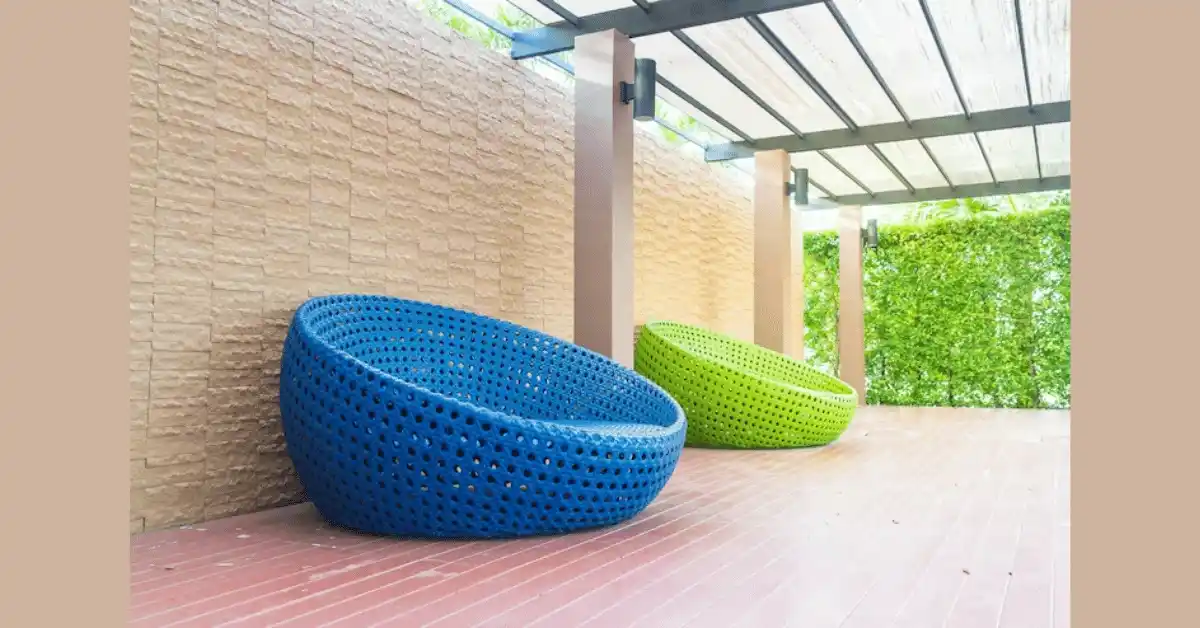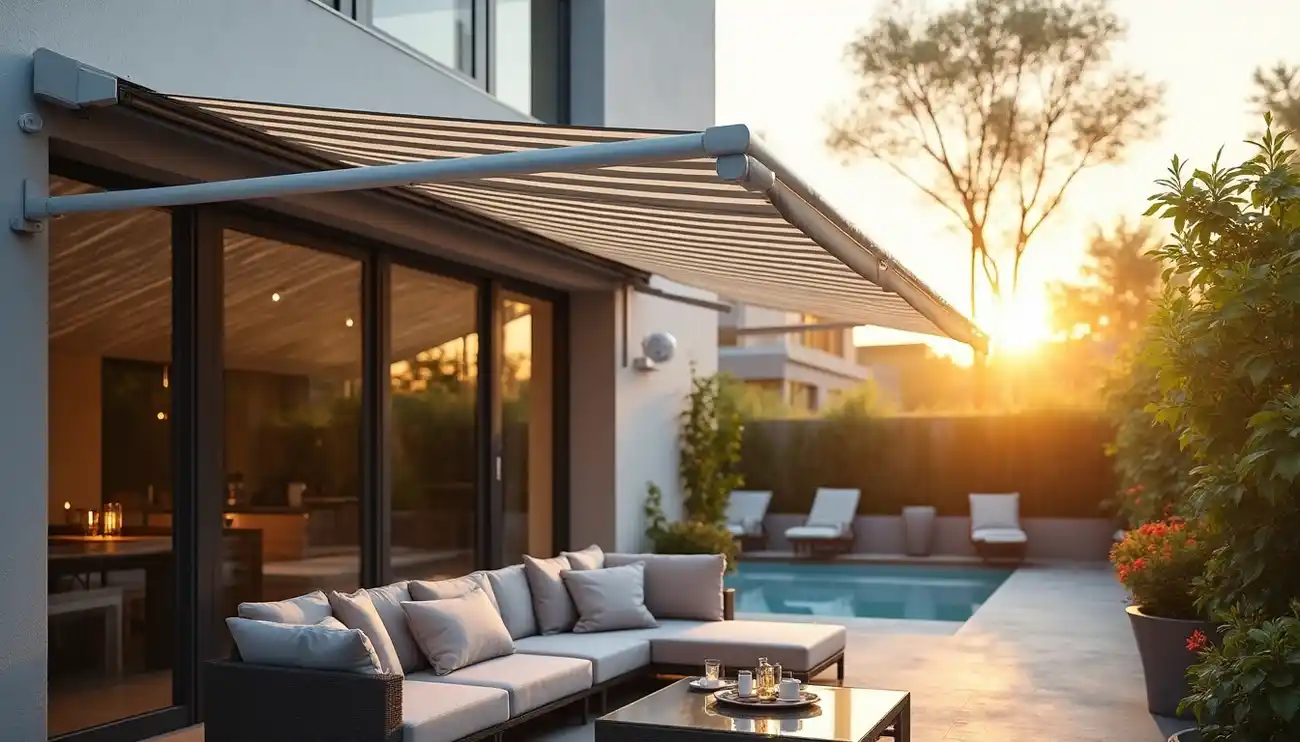Did you know a simple markiseteppe can cut your home’s cooling costs by up to 30%? As people spend more time outdoors for dining, relaxing, or working from home, the need for effective shade solutions has grown significantly.
In 2025, the humble awning has evolved considerably from traditional canvas markeise options. Today’s systems feature high-tech materials, automation, and elegant design, making them both functional and visually appealing. Whether you’re considering a motorized retractable awning (ranging from $900-$2,500+) or exploring specialized options like the fiamma markiseteppe for mobile setups, we’ve got you covered. Modern markiseart options not only protect from harsh UV rays but can last 10-15 years with minimal maintenance.
In this comprehensive guide, we’ll walk you through everything you need to know about selecting, installing, and maintaining the perfect markiseteppe for your space. From material choices to smart features like wind and rain sensors, we’ll help you make an informed decision that enhances your outdoor living experience.
What is a Markiseteppe and Why It Matters in 2025

The term “markiseteppe” combines two Norwegian words—”markise” (awning) and “teppe” (cloth or cover)—creating a perfect description for this versatile outdoor shade solution. Originally developed in Scandinavia, these retractable awnings have become increasingly popular worldwide due to their practicality and elegant design.
Definition and origin of markiseteppe
A markiseteppe is essentially a retractable awning that attaches to a wall or roof and extends outward to provide shade for patios, decks, and gardens. This flexible shading system can be deployed when needed and tucked away when not in use, making it incredibly versatile for changing weather conditions.
The concept embodies the Norwegian cultural value of “friluftsliv”—the joy of being outdoors. In Scandinavian countries with long summer days and variable sunlight patterns, these adaptable shading solutions allow residents to enjoy extended time on balconies and patios regardless of sun intensity.
Beyond their Nordic origins, markisetepper have gained popularity across Europe and now worldwide as elegant, functional additions to outdoor spaces. They combine practical sun protection with esthetic appeal, reflecting both regional design sensibilities and universal needs for comfortable outdoor living.
How it differs from traditional markeise
While traditional fixed awnings remain permanently extended, the markiseteppe offers superior flexibility through its retractable design. This fundamental difference allows homeowners to adjust their outdoor environment based on weather conditions, time of day, or personal preference.
Modern markisetepper feature weather-resistant fabrics, streamlined mechanisms, and sometimes motorized operations—a significant evolution from earlier canvas-based designs. The contemporary versions come in various styles: fully retractable models, fixed options for constant shade, motorized systems with electronic controls, manual crank-operated varieties, and even portable versions for temporary setups.
The sleek, minimalist esthetic of the markiseteppe particularly complements Scandinavian design principles, though adaptations exist worldwide—from vibrant colors in Latin American installations to neutral tones throughout Europe.
Why outdoor shading is more important than ever
As climate patterns shift and extreme weather events increase, protective shading has become essential rather than optional. Modern markisetepper now include features specifically designed to withstand stronger storms, winds, and rain. Some advanced models even incorporate automatic weather sensors that activate shade deployment when detecting high winds or rainfall.
Additionally, markisetepper support sustainable living by enhancing passive climate control. By reducing solar heat gain, especially on south-facing structures, they decrease reliance on air conditioning and contribute to more energy-efficient homes. This passive shading approach represents a key strategy in eco-friendly architecture.
Furthermore, our increasingly busy lifestyles mean many homeowners aren’t available to manually adjust their shades throughout the day. Consequently, automated markiseteppe systems with smart controls have become invaluable for maintaining comfortable outdoor environments with minimal effort.
Types of Markiseteppe and Their Best Use Cases
Choosing the right shade solution starts with understanding the various types of markiseteppe available in the market. Each style offers distinct advantages depending on your specific needs and space constraints.
Retractable vs fixed models
Retractable markiseteppe can be extended or withdrawn based on weather conditions, offering versatility for changing needs. In contrast, fixed models remain permanently installed, providing constant protection without adjustment. While retractable options give you control over sun exposure, fixed awnings typically cost less initially and require minimal maintenance. The choice ultimately depends on whether you prefer flexibility or consistent coverage.
Drop arm and vertical styles
Drop arm awnings mount above windows, using side arms that push the fabric outward at adjustable angles. These are perfect for windows facing strong sunlight, offering targeted shade without completely blocking the view. Vertical screen awnings function more like outdoor blinds, creating fabric walls that block glare and light wind. They work exceptionally well for enclosing pergolas or providing privacy on balconies.
Freestanding and pergola-style options
Freestanding markiseteppe don’t require wall mounting, making them ideal for gardens, pool areas, and commercial spaces where structural attachment isn’t possible. They come with their own support frames and can often be repositioned as needed. Pergola-style awnings combine the elegance of permanent structures with the functionality of retractable fabric, mounted on sturdy frames for expansive coverage.
Motorized vs manual operation
Manual markiseteppe operate via crank handles, offering a budget-friendly option with fewer moving parts to maintain. Motorized systems, however, provide convenience through remote, switch, or app control, and can integrate with sun, wind, and rain sensors for automatic adjustment. For larger installations or hard-to-reach placements, motorized options deliver superior convenience despite their higher initial cost.
Use of fiamma markiseteppe in mobile setups
Fiamma markiseteppe specializes in portable, lightweight awning solutions designed specifically for mobile applications like RVs and campers. These portable systems prioritize easy installation and removal, making them perfect for temporary outdoor spaces while traveling.
Choosing the Right Material and Design for Your Space
Materials make all the difference in how your markiseteppe performs over time. The right choices ensure your outdoor shade solution stands up to the elements while complementing your home’s esthetic.
Acrylic vs polyester vs PVC-coated fabrics
Acrylic fabric stands out as the premium choice for markiseteppe, offering exceptional durability, fade resistance, and breathability—ideal for consistently sunny environments. This material maintains vibrant colors even after years of UV exposure.
Polyester provides a more budget-friendly alternative, though it typically doesn’t last as long as acrylic. Notably, when enhanced with protective coatings, polyester becomes considerably more weather-resistant.
PVC-coated fabrics excel in rainy climates since they’re fully waterproof. Although heavier and less breathable than other options, they deliver superior protection during wet weather.
Frame materials: aluminum vs steel
Aluminum frames dominate the markiseteppe market thanks to their rust-resistant properties and lightweight nature. Unlike steel, aluminum naturally forms an oxide layer that slows corrosion without requiring additional treatments. Moreover, aluminum’s flexibility allows it to bend slightly during high winds, making it surprisingly durable despite weighing significantly less than steel (about one-third the weight).
Steel frames offer tremendous strength but require protective coatings to prevent rust. They’re generally less expensive pound-for-pound than aluminum but heavier overall, sometimes necessitating stronger mounting points.
Color and pattern trends for 2025
Spring/Summer 2025 brings subtle to bold print options with contemporary twists on classic styles. Designers are reimagining traditional patterns using innovative techniques that merge digital and traditional media.
Smart features: sensors, apps, and automation
Modern markiseteppe increasingly incorporate technology that responds to environmental conditions. Wind sensors automatically retract your awning during gusts, whereas rain sensors can either extend or retract depending on your preferences.
How to match markiseteppe with your home’s style
First, consider your home’s architectural elements—clean lines pair beautifully with minimalist Scandinavian-style markiseteppe, whereas ornate buildings might benefit from complementary decorative features. Second, think about whether you want your shade solution to blend in or stand out as a design feature.
Installation, Maintenance, and Cost Considerations

First and foremost, getting your markiseteppe properly installed and maintained ensures maximum performance and lifespan. These practical considerations can make the difference between a shade solution that lasts decades versus one that fails prematurely.
DIY vs professional installation
Many smaller, manual markiseteppe models can be installed as DIY projects, potentially saving significant labor costs. Alternatively, motorized systems or large structures benefit from professional installation to ensure proper anchoring, wiring, and calibration with local building codes. Professional installers bring specialized tools and expertise that DIY approaches can’t match, completing the job much faster while minimizing disruption to your home.
Before deciding, honestly assess your skill level—DIY installations risk warranty voids if improperly done.
Measuring and mounting tips
Accurate measurements are crucial—even slight miscalculations can result in inadequate coverage or wasted space. Consider:
- Wall strength and material (brick, concrete, wood)
- Power outlet locations for motorized systems
- Proper clearance for retraction
- Angle adjustment based on seasonal sun positions
The pitch of your markiseteppe should be adjusted based on the sun’s angle during different seasons—steeper angles provide better protection during low sun angles.
Cleaning and seasonal care
Regular maintenance significantly extends your markiseteppe’s lifespan. Clean fabrics with mild soap and lukewarm water, avoiding harsh chemicals or pressure washers that damage materials. For stubborn stains, specialized fabric cleaners work best, but never use bleach unless specified by the manufacturer.
Inspect frames biannually for rust, loose bolts, or bending. Tighten screws and lubricate joints for smooth operation.
Expected lifespan and warranty factors
A well-maintained markiseteppe can last over a decade. Most manufacturers offer warranties ranging from 5-10 years, but remember that “lifetime warranties” typically refer to the product’s manufacturing lifetime, not your lifetime as owner.
Cost breakdown by type and features
Pricing varies significantly based on style and features:
- Manual folding arm models: €300–€800
- Motorized retractable systems: €900–€2,500
- Custom pergola-style systems: €2,000–€6,000
Factor in additional costs like installation (€200–€500) and smart sensor kits (€150–€400) when budgeting.
Conclusion
As outdoor living spaces become essential extensions of our homes, choosing the right markiseteppe transforms both comfort and energy efficiency. Throughout this guide, we’ve explored how these versatile Norwegian-inspired shade solutions offer far more than simple sun protection. From cutting cooling costs by up to 30% to enhancing your property’s esthetic appeal, the benefits certainly justify the investment.
Understanding the differences between retractable and fixed models, material options, and mounting considerations empowers you to make informed decisions. Acrylic fabrics stand out for durability while aluminum frames provide the ideal balance of strength and weight. Additionally, technological advancements now allow your shade solution to respond automatically to changing weather conditions through smart sensors and automation.
Budget considerations remain important, with options ranging from basic manual systems at €300 to sophisticated motorized installations exceeding €6,000. Remember that professional installation, though adding initial cost, often prevents expensive problems later. Equally important, regular maintenance ensures your markiseteppe delivers optimal performance throughout its decade-plus lifespan.
The perfect markiseteppe balances practical functionality with personal style preferences. Whether you choose vibrant patterns that make a statement or subtle designs that complement your existing architecture, today’s options offer unprecedented flexibility. Ultimately, investing in quality outdoor shading enhances both your property value and your everyday enjoyment of outdoor spaces—a truly worthwhile addition to any home in 2025 and beyond.
FAQs
Q1. What is a markiseteppe and how does it differ from traditional awnings? A markiseteppe is a retractable awning that combines flexibility and style. Unlike traditional fixed awnings, markisetepper can be extended or retracted based on weather conditions, offering versatility and control over sun exposure.
Q2. How much can a markiseteppe reduce home cooling costs? A well-installed markiseteppe can cut your home’s cooling costs by up to 30%. By providing effective shade, it reduces solar heat gain, especially on south-facing structures, decreasing reliance on air conditioning.
Q3. What are the main types of markiseteppe available? The main types include retractable and fixed models, drop arm and vertical styles, freestanding and pergola-style options, and motorized or manual operation systems. There are also specialized options like fiamma markiseteppe for mobile setups.
Q4. What materials are best for markiseteppe fabrics? Acrylic fabric is considered the premium choice for its durability and fade resistance. Polyester is a more budget-friendly option, while PVC-coated fabrics excel in rainy climates due to their waterproof properties.
Q5. How long can a markiseteppe last with proper maintenance? A well-maintained markiseteppe can last over a decade. Regular cleaning with mild soap and lukewarm water, along with biannual inspections for rust or loose bolts, can significantly extend its lifespan. Most manufacturers offer warranties ranging from 5-10 years.
